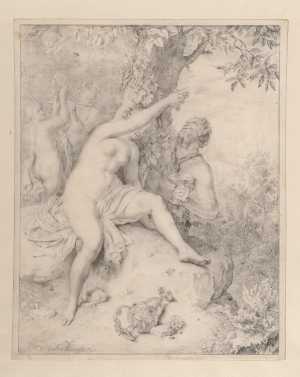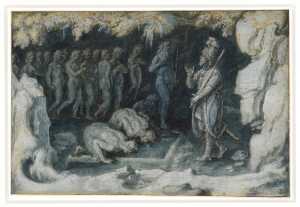Specifications
| Title | Design for an Arch for Alfonso I of Aragon, King of Naples |
|---|---|
| Material and technique | Black chalk, pen and brown ink, brown wash |
| Object type |
Drawing
> Two-dimensional object
> Art object
|
| Location | This object is in storage |
| Dimensions |
Height 249 mm Width 163 mm |
|---|---|
| Artists |
Artist:
Pisanello (Antonio di Puccio Pisano)
|
| Accession number | I 527 (PK) |
| Credits | Loan Stichting Museum Boijmans Van Beuningen (former Koenigs collection), 1940 |
| Department | Drawings & Prints |
| Acquisition date | 1940 |
| Creation date | in circa 1448-1450 |
| Watermark | none ? (poor visibility, laid down, vH, 6P) |
| Inscriptions | 'Bonanu de Ravena' (below centre, pen and brown ink), '64' (below left) |
| Collector | Collector / Franz Koenigs |
| Mark | M. von Fries (L.2903), Marquis de Lagoy (L.1710 twice), F.W. Koenigs (L.1023a) |
| Provenance | Count Moriz von Fries (1777-1826, L.2903), Vienna, until c. 1820, to mr. W. Mellish, London; Marquis de Lagoy (1764-1829, L.1710)***, Aix-en-Provence; - ; Franz W. Koenigs (1881-1941, L.1023a), Haarlem, acquired in 1930 (North Italian, c. 1400, corrected to Pisanello attrib.); D.G. van Beuningen (1877-1955), Rotterdam, acquired with the Koenigs Collection in 1940 and donated to Stichting Museum Boijmans Van Beuningen |
| Exhibitions | Amsterdam 1934, no. 453; Rotterdam 1938-39, no. 51; Rotterdam 1952, no. 80; Paris/Rotterdam/Haarlem 1962, no. 14; Paris/Verona 1996, no. 290; London 2001, no. 131; Rotterdam 2010-11 (coll 2 kw 9) |
| Internal exhibitions |
Tekeningen uit eigen bezit, 1400-1800 (1952) Italiaanse tekeningen in Nederlands bezit (1962) De Collectie Twee - wissel IX, Prenten & Tekeningen (2011) |
| Research |
Show research Italian Drawings 1400-1600 |
| Literature | Burger 1907, pp. 67, 70; Planiscig 1933, p. 18; Filangieri di Candida 1933, pp. 75-80; Thieme/Becker 1907-50, vol. 27 (1933), p. 93; Filangieri di Candida 1934, pp. 109 ill., 112, 115; Amsterdam 1934, no. 453, ill. (Neapolitan school, c. 1450); Rotterdam 1938-39, no. 51 (Neapolitan school, c. 1450); Degenhart 1941, p. 49-51, fig. 121 (not Pisanello); Degenhart 1945, p. 49-51, 78, fig. 121 (Pisanello circle); Degenhart 1949, p. 16, n. 1; Haverkamp Begemann 1952, no. 80; De Marinis 1947-1952, vol. 1, p. 140, no. 20; Causa 1954, pp. 6-7, 22, n. 6; Keller 1957, p. 139; Pope-Hennessy 1958, pp. 80-81, fig. 114; Degenhart/Schmitt 1960, pp. 88, 137 139, 144, 146; Paris/Rotterdam/Haarlem 1962, no. 14, pl. 13; Degenhart 1963, p. 615; Scheller 1963, pp. 175, 183, 184 n. 14; Chastel 1965, p. 201, fig. 189; Fossi Todorow 1966, no. 165, ill. 107, under nos. 73, 155, 158-161, 408 (not Pisanello); Magagnato 1966, p. 290; Degenhart/Schmitt 1968, vol. I 2, pp. 640 fig. 980, 641 (Pisanello); Hersey 1969, pp. 16 24; Baxandall 1971, p. 112, pl. 12 (style of Pisanello); Sciolla 1972, pp. 70, 72 n. 13, fig. 1; Hersey 1973, pp. 9, 21 29, fig. 16; Verga 1974, p. 57 n. 1 and 3, p. 58 n. 19; Malmanger 1974, pp. 223-24; Kruft 1974, p. 679; Blunt 1975, p. 10; Hersey/Kruft 1975, pp. 393-94, fig. 95; Kruft/Malmanger 1977, pp. 236, 247, 266-67, fig. 96; Pane 1975-77, vol. 1, p. 125, 129, 166-174, fig. 149, vol. 2, pp. 300-02, 322 n. 3; Bologna 1977, pp. 98-99; Bush 1978, pp. 55, 57, fig. 21; Lightbown 1978, pp. 269, 270; Florence 1983, under no. 8; Bologna 1987, p. 16 (Dello Delli); Zeri 1987, vol. 2, p. 452, 458, fig. 640 (Dello Delli); Vignola 1988, under no. 43; Cieri Via 1989, p. 52-53, fig. 1; Leone de Castris 1990, p. 41; Ryder 1990, p. 346 n. 110; Quinterio 1991, p. 407, fig. 5; Cole 1995, pp. 44, 45, 46 fig. 31; Cordellier 1995, pp. 119, 127-28; Paris/Verona 1996, no. 290, p. 415, ill.; Filippi 1996, pp. 216, 217 ill.; Blass-Simmen 1998, pp. 589, 614 fig. 31 (Pisanello); Di Battista 1999, pp. 10-14, 20 n. 19, 21; Serra Desfilis 2000, p. 15 n. 48; London 2001, nr. 131, pp. 233, 235, ill.; Degenhart/Schmitt 2004, vol. III-2, under no. 759, fig. 352; Bodart 2008, p. 60, ill.; Quintavalle 2009, p. 653 fig. 19, pp. 666-67, n. 118; Furlan/Venturi 2010, vol. 1, pp. 239, 242 fig. 20, vol. 2, p. 233; Payne 2014, p. 442 |
| Material | |
| Object | |
| Geographical origin | Italy > Southern Europe > Europe |
Do you have corrections or additional information about this work? Please, send us a message
























